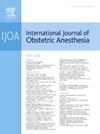P6 acupressure versus sham acupressure for prevention of intraoperative nausea and vomiting during cesarean delivery under neuraxial anesthesia: a randomized controlled trial
IF 2.6
3区 医学
Q2 ANESTHESIOLOGY
引用次数: 0
Abstract
Introduction
Intraoperative and postoperative nausea and vomiting (IONV and PONV) are common during cesarean delivery (CD) with neuraxial anesthesia. Limited information exists on the antiemetic benefit of combined P6 acupoint stimulation with acupressure (P6 acupressure) and pharmacologic antiemetics on preventing IONV and PONV after CD. This study assessed the antiemetic efficacy of P6 acupressure compared to a non-P6 acupoint stimulation with acupressure (sham acupressure) in preventing IONV during CD.
Methods
We performed a randomized double-blinded trial comparing the efficacy of intraprocedural P6 acupressure versus sham acupressure in preventing IONV during CD after following the Society for Obstetric Anesthesia and Perinatology enhanced recovery recommendations. Subjects were instructed to apply additional pressure at the acupressure sites when they perceived nausea. The primary outcome was the incidence of IONV, and the secondary outcome was the need for rescue antiemetic treatment.
Results
Ninety-nine P6 acupressure and 100 sham acupressure subjects were studied. There was no difference in the incidence of intraoperative nausea (67%), vomiting (17%), emesis episodes, or the need for rescue antiemetics intraoperatively. There were also no differences in the incidence of PONV and antiemetic treatment from PACU to discharge. At discharge, 70% of respondents reported experiencing nausea, but only 10% reported it affected self-care. Approximately 50% of the patients in both groups were satisfied with acupressure therapy.
Conclusion
P6 acupressure did not reduce the incidence of IONV or PONV when combined with antiemetic therapy per enhanced recovery recommendations. There does not appear to be sufficient evidence to support using P6 acupressure for IONV prevention.
P6 穴位按摩与假穴位按摩预防神经麻醉下剖宫产术中恶心和呕吐:随机对照试验
在采用神经麻醉的剖宫产(CD)过程中,术中和术后恶心和呕吐(IONV 和 PONV)很常见。关于结合 P6 穴位刺激与穴位按摩(P6 穴位按摩)和药物止吐药对预防 CD 术后 IONV 和 PONV 的止吐效果的信息十分有限。本研究评估了 P6 穴位按摩与非 P6 穴位刺激加穴位按摩(假穴位按摩)在预防 CD 期间 IONV 方面的止吐效果。我们按照产科麻醉和围产医学会的强化恢复建议,进行了一项随机双盲试验,比较术中 P6 穴位按压与假穴位按压在预防 CD 期间 IONV 方面的疗效。研究人员指导受试者在感到恶心时在穴位按摩部位施加额外压力。主要结果是IONV的发生率,次要结果是是否需要止吐治疗。研究对象包括99名P6穴位按摩受试者和100名假穴位按摩受试者。在术中恶心(67%)、呕吐(17%)、呃逆发作率或术中止吐药抢救需求方面没有差异。从 PACU 到出院,PONV 和止吐治疗的发生率也没有差异。出院时,70% 的受访者表示有恶心症状,但只有 10% 的受访者表示恶心影响了生活自理。两组中约有 50% 的患者对穴位按摩疗法表示满意。根据强化恢复建议,P6穴位按摩与止吐疗法结合使用时,并未降低IONV或PONV的发生率。似乎没有足够的证据支持使用P6穴位按摩来预防IONV。
本文章由计算机程序翻译,如有差异,请以英文原文为准。
求助全文
约1分钟内获得全文
求助全文
来源期刊
CiteScore
4.70
自引率
7.10%
发文量
285
审稿时长
58 days
期刊介绍:
The International Journal of Obstetric Anesthesia is the only journal publishing original articles devoted exclusively to obstetric anesthesia and bringing together all three of its principal components; anesthesia care for operative delivery and the perioperative period, pain relief in labour and care of the critically ill obstetric patient.
• Original research (both clinical and laboratory), short reports and case reports will be considered.
• The journal also publishes invited review articles and debates on topical and controversial subjects in the area of obstetric anesthesia.
• Articles on related topics such as perinatal physiology and pharmacology and all subjects of importance to obstetric anaesthetists/anesthesiologists are also welcome.
The journal is peer-reviewed by international experts. Scholarship is stressed to include the focus on discovery, application of knowledge across fields, and informing the medical community. Through the peer-review process, we hope to attest to the quality of scholarships and guide the Journal to extend and transform knowledge in this important and expanding area.

 求助内容:
求助内容: 应助结果提醒方式:
应助结果提醒方式:


